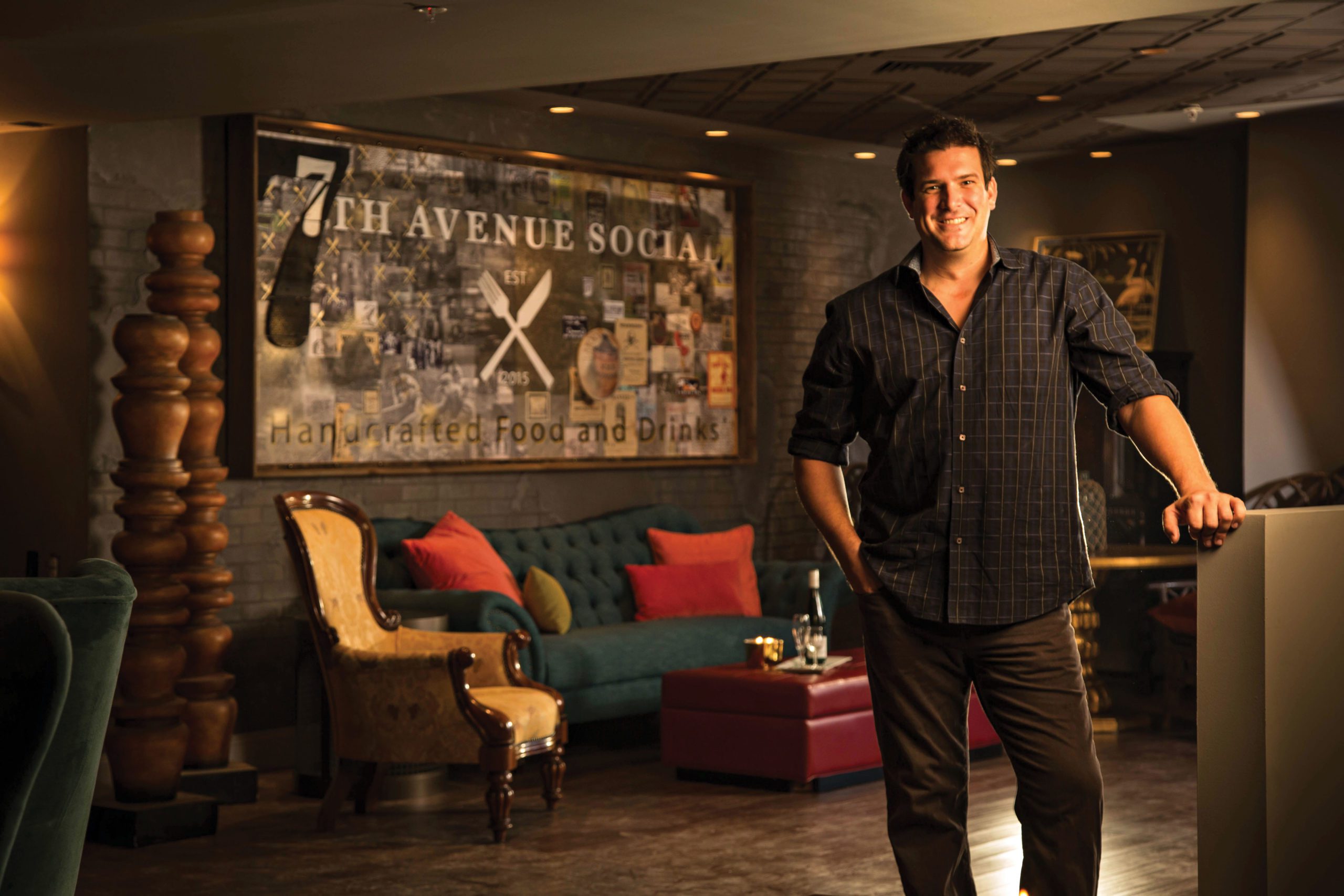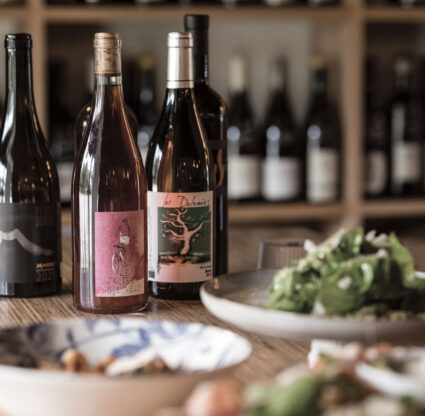I’ve been covering Southwest Florida food for the better part of the last decade (with the waistline to prove it). I’ve eaten brilliant meals created by fantastic chefs and more than my fair share of overpriced mediocre dishes. I’ve talked to chefs about their passions and felt like following them wherever they went. I’ve chatted with owners who were pretty obviously going to fail.
The one question I keep asking myself is, why? Why start a restaurant? Why be in a business that will put you on top of the world one minute and leave you in the recycling bin the next? From a distance, it looks cool; up close, the reality can leave you burned—badly burned. The facts: Thirty percent of restaurants fail in the first year and 50 percent are done after three.
Yet people continue opening restaurants, even in a market flooded with them. Some do it so many times you wonder if they may be delusional. Colin Estrem has wanted to own a restaurant since he was a 17-year-old kid working a station at a Minneapolis steakhouse. By sometime this very month of March, he will have done just that with his 7th Avenue Social. It took him half his life to get there and a significant amount of financial risk. At 35 years old, he has taken the step that could put him on a path to a successful business empire. (He’s already got one business up and running—Avenue Wine Café—and he’s mentioned other restaurant concepts he’d like to try.) But this decision could have serious financial repercussions.
 Estrem is confident in his ability to make it work. And it wasn’t ever a question of if, but when. “It’s not courage or being more intelligent,” he says. “There’s just something in you that says you have to do this and that it’s going to work. It’s something innate. (To open a restaurant) you have to throw a bit of caution to the wind. I trust my gut.”
Estrem is confident in his ability to make it work. And it wasn’t ever a question of if, but when. “It’s not courage or being more intelligent,” he says. “There’s just something in you that says you have to do this and that it’s going to work. It’s something innate. (To open a restaurant) you have to throw a bit of caution to the wind. I trust my gut.”
The question then is, why is Estrem’s gut right when so many others have been wrong?
The restaurant space at 849 Seventh Ave. S. has gone through several incarnations over the past decade or so. From memory, I can recall Nektar, Gina’s 7th Ave., Backstreet Bar and Grill, and, most recently, Flava. A quick Internet search of the address pulled up places called “Fennel” and “Bravissimo,” too. I don’t think those ever opened.
Most never made it to the two-year mark. Nektar was ensnared in an embezzlement case. The Backstreet Bar and Grill was an attempt by the Pate family, longtime Naples restaurant owners, to revive the spot. It limped out of business in less than 18 months. Flava made it nearly two and a half years before shutting its doors in June. For the past eight months, the space has been empty.
“So is it the operators or the location? That’s the big question for Colin,” says Tony Ridgway, who has operated restaurants in Naples for the past 40 years. “It could be that the other people didn’t know what they were doing. It could be that it’s just not a good spot for a restaurant.”
Estrem’s bet is that his knowledge of the industry, his six years of owning and operating his beer and wine bar on Fifth Avenue South, along with a singular concept—South Florida cuisine—will be a better mix than anything his predecessors brought to the table.
Ridgway guesses Estrem will know within a month of being open if he’s right. Estrem says by summer. Suzanne Specht, assistant director at the Florida Business Development Center at Florida Gulf Coast University, has worked with Estrem on both of his businesses, from developing business plans to helping him look for funding. She says if previous failures can be chalked up to operational missteps, then Estrem should succeed.
He’s done his due diligence, she says. “We’ve run the numbers. He knows what he has to do to make it work. He’s figured out the number of customers he needs. He’s done the market research and understands the demographics. And he’s had a good track record of running a business already.”
For his part, Estrem says he feels he could have started a restaurant when he opened Avenue Wine Café six years ago. In fact, that was the plan. He sort of backed into the bar business after realizing the amount of money needed to renovate the space wasn’t feasible. As if to prove that the decision not to turn Avenue into a full restaurant was correct, Estrem had a front-row seat to his next door neighbor, Osetra, as the caviar/champagne bar and restaurant went through a lot of growing pains before being sold six months ago.
Estrem and his wife/business partner, Kitsi, moved to Naples for her to take a job with Campiello, the Italian eatery on Third Street South run by his restaurant business idol Richard D’Amico. Estrem quickly took a job working the broiler at Cafe Lurcat, another D’Amico restaurant. But he realized pretty soon that while he loved food, he was better-suited for other parts of the operation. He bounced around through a few different roles with D’Amico’s local operations and elsewhere before winding up running the wine program at Cafe Lurcat under Jeff Mitchell, who has come to prominence here for his restaurant The Local. Through his roles he learned the business side of the restaurant industry, staff management, product costs, ordering and more. And while at Lurcat, he started frequenting a small cigar store that sold a few beers across the street. Then the owner mentioned he was looking to sell. With a bit of seed money from a family member, Estrem quit his job at Lurcat and opened Avenue Wine Café.
*
Starting a restaurant is extremely capital-intensive. If you are an accountant, you need an office, a phone line and a laptop and you are up and running. You can do it out of your spare bedroom while you build up a client base large enough to support a storefront operation. Get a dozen or so clients and you are already looking to expand.
Estrem won’t say exactly how much he will need to spend before he opens up for his first customers, but I speculated on a conservative estimate of $400,000 to Ridgway and he agreed. It could easily be more. Estrem is saving costs by renting a space with some of the restaurant infrastructure already in place, a strategy used by a lot of people, from Charles Mereday for his three restaurants to Richard D’Amico for his recently opened The Continental. But even this plan netted him only a few walk-in coolers and a hood ventilation system.
He still needs to put in an entire kitchen, from ovens and ranges to dishwashing equipment. He has to install new flooring, wall treatments, lights and storage. He needs tables, chairs, flatware, dinnerware and glassware, all of which cost more than what you would buy for your house because they need to be durable yet not feel industrial.
 He needs to spend money on marketing, from signage to Facebook. He has to hire a chef, which he did about a month out from his open date, and a manager, plus another 35 staff members from servers and bartenders to line cooks and dishwashers. And he needs to pay all of them for a few months until money to cover the human costs starts coming in.
He needs to spend money on marketing, from signage to Facebook. He has to hire a chef, which he did about a month out from his open date, and a manager, plus another 35 staff members from servers and bartenders to line cooks and dishwashers. And he needs to pay all of them for a few months until money to cover the human costs starts coming in.
And all of that is before he buys the food and beverages to serve to his first customers.
“You have all these doubts,” he says. “Is this really a viable business or are you just buying yourself a job?”
Beyond the fears and insecurities anyone feels with a start-up, there’s the stress of knowing your family’s financial security depends on doing it right. When Estrem opened Avenue, he was just a newlywed. Now he’s a father of two girls. It’s no small wonder he isn’t sleeping much these days.
“I normally hibernate each night,” he says. “Now I’m up every day at 3:30 in the morning thinking about how things are going to work. Thinking about customer interactions, menu ideas.”
Both of those things are important. A good menu and good customer service lead to repeat business. And that’s crucial. Running a restaurant is a numbers game, plain and simple. If you need to make $2 million to cover your expenses, your food cost is 30 percent and your average per table is $50, then you need to turn over 157 tables a day, every day of the year to break even. Average 10 tables more and you are up $130,000. Average 10 fewer and you aren’t paying yourself. If it’s 20 a day fewer, you aren’t in business. The more money per table you make, the fewer customers you need, which is a good thing because you are probably going to have fewer customers due to higher prices.
Very little of that calculus has anything to do with how good your food is. I’ve been in more than a few local restaurants with food I wouldn’t recommend to anyone and they keep churning out a profit year after year. I’ve eaten at a few wonderful restaurants that closed despite serving excellent meals.
Some of that is hubris. Every time I read a menu that touts where it sources its produce (excluding those that are doing it locally, which I think is an important distinction), I play a little mental game where I try to guess how much that handful of carrots cost. If they are from the Chef’s Garden in Ohio—exceedingly popular among chefs but little-known except to the most food-obsessed—I’m guessing there’s $7 worth of produce on the plate. For five carrots.
And some of it is circumstance. How many restaurant owners misjudged when to expand to another location or change the concept and failed? Ridgway has been running a restaurant in the same location as his eponymous bar and grill for decades. Some worked—people still talk about the Chef’s Garden in reverential tones. Others didn’t—he’ll admit to making a mistake by closing Chef’s Garden to open Terra.
“You can run a great restaurant and make no money,” Ridgway says. “And you can run a good restaurant and make obscene money.”
*
Walking with Estrem through the empty space that will be his restaurant, it’s hard not to get caught up in his enthusiasm. He’s talking about the quality of the cocktails he’s going to serve, gushing about the pickles he’s been experimenting with and positively beaming about the new kitchen equipment that’s about to be installed.
As he explains his vision for the layout, I’m reminded of a recent conversation with Vincenzo Betulia, another D’Amico graduate, who was in Estrem’s shoes just about two years ago opening his Osteria Tulia.
“Opening a restaurant is like having a baby,” Betulia says. “You do nothing but think about it for nine months. You plan, you strategize, you worry over every detail. And then it happens and you realize you still have no idea what’s going on. You can read all the books you want, but until it happens you can’t actually prepare enough.”
Estrem has done a good job managing his first business, creating a place that is profitable and fun. Avenue is one of my favorite haunts. There’s usually decent music—depending on who is running the Pandora station—always great beer on tap and the best bartenders in Southwest Florida. I’ve been going there since stumbling on it while looking for a place to watch the Christmas parade in 2009.
Over the years, I’ve become friendly with the regulars and with Estrem. We bonded over a shared love of good drink and food. We gossiped about the openings and closings of local restaurants, compared notes on places we’d recently eaten and complained about the general lack of ambition in the local culinary scene. Thankfully, that last problem has changed dramatically for the better in the past five years thanks to restaurants such as The Local, Osteria Tulia, Mereday’s Fine Dining and Fuse Global Cuisine.
For the past year and a half, I’ve followed closely Estrem’s attempts to start his first restaurant. I’ve watched him nearly pull the trigger on a different location before negotiations fell apart. And I remember vividly my first reaction when he told me he’d signed the lease.
“Oh, God. That place is cursed,” I thought while trying to smile and nod.
I want 7th Avenue Social to succeed because I like what it’s selling: a bar-centric place to meet up with friends and grab a few beers and something to eat without being in the middle of the downtown crush. “This isn’t going to be a place only to come in have a salad, an entrée and dessert and then leave,” Estrem says. “It’s a place to gather, socialize, have a few drinks, a little food and relax.”
I want it to succeed because I like its vision of a South Florida cuisine. He cites local historian and food writer Doris Reynolds’ Naples cookbook as an inspiration. While other chefs have focused on using locally sourced ingredients, few are doing it as a way to explore our culinary heritage. Estrem mentions Norman Van Aken and Charleston chef/heritage food superstar Sean Brock as another inspirations.
I want it to succeed because if it does, more young adventurous industry types might decide to follow their passion projects and create a whole cast of places that are just a little bit off center of what Naples has to offer.
However, after seeing so many restaurants open and close, I absolutely won’t be surprised if it doesn’t work. Being a smart, decent human isn’t enough to own a restaurant and succeed, even if it doesn’t hurt. But Estrem’s ability to turn a struggling cigar bar into one of the more popular watering holes on Fifth Avenue simply by reimagining the concept makes me think he has a fighting chance.






